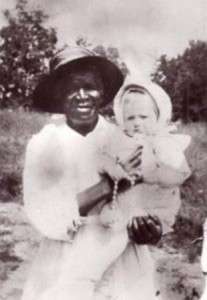Julia Greeley
Julia Greeley (ca. 1833-48 – 7 June 1918), was a Black American enslaved woman, later freed by the Missouri Legislature.
| Laywoman | |
|---|---|
| Born | ca. 1833-48 Hannibal, Missouri, United States |
| Died | 7 June 1918 Denver, Colorado, United States |
| Venerated in | Roman Catholic Church |
| Patronage | Black Americans, slaves, Denver |

Life and career
Greeley was born into slavery in Hannibal, Missouri. At the age of five, her right eye was injured by a slave master as he was whipping her mother. This disfigurement remained with Greeley the rest of her life. In 1865, she was freed under the Emancipation Proclamation and became a cook and nanny to Julia Pratte Dickerson of St. Louis who would later marry William Gilpin. When President Abraham Lincoln appointed Gilpin as the territorial Governor of Colorado, the couple moved to Denver and Greeley joined them.
Greeley was baptized into the Catholic Church in 1880 at Sacred Heart Church in Denver, and became especially devoted to the Most Sacred Heart of Jesus, the Blessed Virgin Mary, and the Holy Eucharist, receiving Holy Communion daily. Despite secretly suffering from painful arthritis, she tirelessly walked the city streets distributing literature from the Sacred Heart League to Catholics and non-Catholics alike.
She became known for her charitable works, pulling a red wagon through the streets of Denver in the dark to bring food, coal, clothing, and groceries to needy families. She made her rounds after dark so as not to embarrass white families ashamed to accept charity from a poor, black woman.[1]
In 1901, Greeley joined the Secular Franciscans and remained an active member for the rest of her life. In recognition of her dedication to the poor, Greeley has been dubbed "Denver's Angel of Charity." In January 2014, the Roman Catholic Archdiocese of Denver officially opened an investigation for her sainthood.[2][3]
Greeley is one of the four people that U.S. bishops voted to allow to be investigated for possible sainthood at their fall meeting. She joins four other African Americans placed into consideration in recent years. She is also the first person to be interred in the Denver cathedral since it opened in 1912.[3]
References
- Brown, Jennifer. "Ex-slave who helped Denver’s poor could become first saint from Colorado", Colorado Sun, August 9, 2018
- "Julia Greeley: "A woman with a wide-winged spirit"". juliagreeleyhome.org. 9 April 2018.
- "Remains of former slave Julia Greeley moved to Denver church as she is considered for sainthood". denverpost.com. 9 April 2018.
External links
- Julia Greeley Guild official website
- Former slave Julia Greeley first to be buried at Denver’s Cathedral